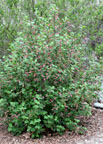12. Ribes malvaceum “Currant/Gooseberry” Kochar
Food: All 30 species are edible. Dried currants were pounded into meat and fat to make “pemmican”, a staple of Tongva diet. Leaves and twigs of several species were boiled and eaten in times of need. Berries are high in vitamin C, phosphorus, and iron.
Medicinal: Ribes aureum “Golden Currant” was used as a poultice for pains and soreness. Dried inner bark was pulverized and smeared on sores or for pains. A decoction of the inner bark was drunk for leg swellings. The leaves of most species could be used as wound dressing. The juice of the fruit is astringent and used for sore throats, burns, and fevers.
Ribes indecorum “White Flowering Currant” roots, as well as the dried leaves, were used for toothaches. Ribes malvaceum “Chaparral Currant” currants were used as an additive in many remedies to treat stomach aches. The root was used for toothaches.
Ribes cereum “Wax Currant” berries were made into a remedy for stomachaches. Ribes californicum “Hillside Gooseberry” berries were eaten to promote the flow of urine. Washes of californicum were used to cure canker sores. Teas reduced fever and improved appetite, and comforted pregnant women.
Construction: The wood of most species made good arrow shafts.
Warning: Eaten in large doses it is an emetic.
Shrub.
Blossoming for Ribes speciosum January to May and is found in shaded canyons below 1500 ft; Chaparral, Coastal Sage Scrub and inland to San Dimas .
Blossoming for Ribes aureum March to April, orange-yellow. Found in wooded canyons; chaparral.
Blossoming for Ribes indecorum November to March, white. Found in interior washes and canyons usually below 2000 ft.
Ribes malvaceum is found in dry wooded or open hills, below 2500 ft.; Chaparral; Foothill Woodlands; Closed-cone Pine forest.
